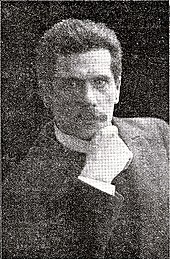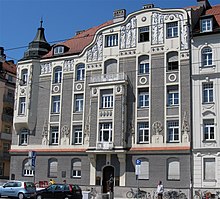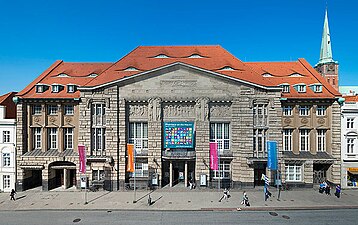Martin Dülfer
Martin Dülfer (born January 1, 1859 in Breslau ; † December 21, 1942 in Dresden ) was a German architect and university professor who was particularly noted for his theater buildings and designs and became an important representative of historicism and German Art Nouveau architecture heard.
life and work
Dülfer was born in 1859 in Breslau as the son of the publisher Carl Dülfer. After the secondary school in Breslau, he first attended the trade school in Schweidnitz . He then studied from 1877 to 1879 at the Technical University of Hanover with Conrad Wilhelm Hase and from 1879 to 1880 at the Technical University of Stuttgart (presumably) with Christian Friedrich von Leins . In Hanover he joined the Corps Visurgia . In 1880/81 Dülfer did his military service. He then decided to do a practical job and worked in the prestigious Berlin architectural office of Heinrich Kayser and Karl von Großheim , and later in his home town of Breslau in the Brost und Grosser office . In 1885/86 he completed his studies at the Technical University of Munich under Friedrich von Thiersch .

Dülfer began his independent activity in Munich in 1887, initially building in the neo-baroque variant of historicism typical of the time and region . Around 1900 he turned to Art Nouveau , whose floral, geometric and textural repertoire he combined with Baroque and Classicist style elements to create an individually shaped, Baroque-style Art Nouveau. Façade designs, apartment buildings, commercial buildings and villas for the upper class were created.
1899–1900 Dülfer was able to build his first theater in Merano in the Burggrafenamt , which was to be followed by four more over the years. In addition to the five completed projects, there were also a large number of non-implemented competition designs, some of which failed due to adverse external circumstances despite being awarded first prize.
In 1902 Dülfer received the honorary title Royal Bavarian Professor ( titular professor ). In 1906 he was appointed full professor of building design at the Technical University of Dresden as the successor to Karl Weißbach . From 1912 Dülfer was “head” ( dean ) of the building construction department, rector from 1920 to 1921 and immediately afterwards prorector of the university for two years . He was a member of several professional associations and artists' associations, from 1908 to 1912 he was chairman of the Association of German Architects (BDA). In Dresden he joined the artists' association Die Zunft , which was first headed by the city planner Hans Erlwein and later by Georg Wrba . In 1909 he was a founding member of the Dresden Artists' Association .
In the summer of 1911 Dülfer was awarded the Prussian Crown Order III. Class excellent. In 1913 the Dresden University of Technology awarded him an honorary doctorate (Dr.-Ing. E. h.), And a second honorary doctorate in 1928 from the Berlin University of Technology . In 1929 Dülfer retired from Dresden University . After that, the public did not notice him again until his 80th birthday (1939); despite a Freemason - Lodge had listened and thus actually considered "unreliable" in the sense of Nazi cultural policy, it was to mark the occasion Goethe Medal awarded.
In 1893 Dülfer had Käte, born in 1865, also in Breslau. Weigand (t) married, the marriage apparently remained childless. After Dülfer's visit to the 1904 World Exhibition in St. Louis (USA), an illegitimate daughter was born there in 1905, to whom he openly confessed. In 1915, the Dülfer couple adopted a nine-year-old boy named Kurt, whom some contemporary witnesses also believed to be Dülfer's illegitimate child; According to other information, this child is said to have belonged to Käte Dülfer's relatives.
Martin Dülfer died at the end of 1942, Käte Dülfer came during the air raid on Dresden on 13/14. Killed in February 1945 , during which Dülfer's estate was also destroyed. Dülfer's grave in the Old Annenfriedhof was destroyed in 1945. His is commemorated today in the memorial for professors of the Technical University of Dresden in the cemetery.
Buildings and designs (selection)
- 1892–1893: State and City Library Augsburg
- 1897/1899: "Luitpold-Brunnen" or "Prinzregenten-Brunnen" in Kulmbach
- 1895: Tomb for Georg Pschorr in Munich , on the old southern cemetery
- 1895: Villa in Grafrath , Marthashofen district
- 1896–1898: Villa Bechtolsheim in Munich , Maria-Theresia-Strasse 27
- 1897–1898: Office building of the F. Bruckmann publishing house in Munich-Neuhausen , Nymphenburger Strasse 86
- 1898–1901: residential development for the building contractor Friedrich Wagner in Munich, Kaulbachstrasse 22–26 (partially preserved and under monument protection)
- 1898: Tenement at Adalbertstrasse 98 in Munich
- 1899–1900: City Theater in Meran ( South Tyrol , then Austria), Theaterplatz 2
- 1900–1901: Office building of the publishing house of the Münchner Allgemeine Zeitung in Munich, Bayerstraße 57/59.
The building is regarded as a key building of the Art Nouveau. The facade with its original lively play of colors was thoroughly "modernized" in 1929 when Art Nouveau was not appreciated. - 1902: Own Baroque art nouveau house in Krailling
- 1902: Becker tomb in Berlin-Weißensee , on the Jewish cemetery (together with his colleague Paul Ludwig Troost )
- 1902–1903: "Hotel Terminus" in Munich, Bayerstraße 43 and Mittererstraße 1
- 1903–1904: Stadttheater Dortmund , Hiltropwall 15 (with the assistance of Heinrich Tessenow ) (destroyed in the war)
- 1904: District Council Hall for the presidential building of the government of Upper Franconia in Bayreuth (awarded a Grand Prix at the World Exhibition in St. Louis)
- 1904: Competition design for the city theater in Gießen (one of two 2nd prizes)
- 1905: Competition design for the city theater in Osnabrück (not executed)
- 1905–1906: House for the manufacturer Wilhelm Schenk, owner of the Muffler & Comp. in Freiburg im Breisgau , Waldsee district , Schwarzwaldstraße 90 (preserved with minor changes, today used as a kindergarten for the parish of St. Carolus)
- 1907: Schneider office building in Wiesbaden , Kirchgasse (demolished)
- 1907: Temple of Music at the Dortmund City Theater
- 1907–1908: House for the businessman Carl Philipson in Osnabrück (destroyed in 1945)
- 1907–1908: City Theater in Lübeck , Beckergrube (restored 1993–1996)
- 1908: Competition design for the Royal Württemberg Court Theater in Stuttgart (not executed)
- 1909: Competition draft for the city theater in Bremerhaven (not executed)
- 1909: Competition design for the city theater in Hagen (1st prize, not executed)
- 1910: Competition design for the New Royal Opera House in Berlin (2nd prize, not executed)
- 1910–1911: Conversion of the Hotel Bellevue on Theaterplatz in Dresden (destroyed in 1945, ruin torn down in 1951)
- 1910–1912: Office and commercial building with a branch of Dresdner Bank AG in Leipzig , Goethestrasse 3 (restored in 1995/1996)
- 1910–1913: Beyer building of the Technical University of Dresden , in the Südvorstadt , George-Bähr-Straße 1 (changed)
- 1911–1912: City Theater in Duisburg , König-Heinrich-Platz (interior heavily changed after war damage)
- 1913: Competition design for the city theater in Krefeld (1st prize, not executed)
- 1913: Competition design for the Stadttheater am Servatiiplatz in Münster (1st prize, revised in 1929, not executed)
- 1922–1926: Fritz-Foerster-Bau (with König-Bau and Müller-Bau) of the Technical University of Dresden, in the Südvorstadt, Mommsenstraße 6 (preliminary planning since 1917)
- 1925–1929: Bulgarian National Theater in Sofia (renovation and expansion after fire damage)
- 1930 (?): Design of a theater in Novi Sad (Yugoslavia)
literature
- Dieter Klein: Martin Dülfer. Pioneer of German Art Nouveau architecture. (= Workbooks of the Bavarian State Office for Monument Preservation , 8th) 2nd, extended edition, Verlag Lipp, Munich 1993, ISBN 3-87490-531-4 .
- Otto Schubert: Dülfer, Martin. In: New German Biography (NDB). Volume 4, Duncker & Humblot, Berlin 1959, ISBN 3-428-00185-0 , p. 159 f. ( Digitized version ).
Web links
- Literature by and about Martin Dülfer in the catalog of the German National Library
- Martin Dülfer. In: arch INFORM .
- Martin Dülfer
Individual evidence
- ↑ 100 years of Weinheim Senior Citizens' Convention. Bochum 1963, p. 142.
- ↑ Georg Sperlich. Lord Mayor of Münster in the Weimar Republic. Münster 2006, p. 211.
| personal data | |
|---|---|
| SURNAME | Dülfer, Martin |
| BRIEF DESCRIPTION | German architect and university professor |
| DATE OF BIRTH | January 1, 1859 |
| PLACE OF BIRTH | Wroclaw |
| DATE OF DEATH | December 21, 1942 |
| Place of death | Dresden |








